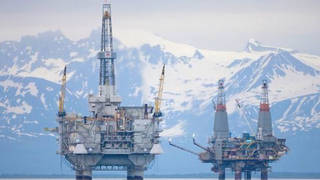
Topics
Guests
- James Bamfordlongtime investigative journalist and author of the recent Foreign Policy piece, “Frozen Assets: The Newest Front in Global Espionage is One of the Least Habitable Locales on Earth—the Arctic.” He has covered the National Security Agency for the last three decades and helped expose the NSA’s existence in the 1980s. His books include The Shadow Factory: The Ultra-Secret NSA from 9/11 to the Eavesdropping on America.
President Barack Obama arrived in Alaska on Monday for a three-day tour during which he will become the first sitting U.S. president to visit the Alaska Arctic. On Monday, Obama highlighted the dangers posed by climate change in the region. “Arctic temperatures are rising about twice as fast as the global average,” Obama said. “Over the past 60 years, Alaska has warmed about twice as fast as the rest of the United States.” As the Arctic region warms, the geopolitical significance of the region is growing as new areas become reachable, spurring maritime traffic and oil drilling. Resources below the Arctic ice cap are worth over $17 trillion, the rough equivalent of the entire U.S. economy. According to investigative journalist James Bamford, the region has become the “crossroads of technical espionage” as the United States, Russia, Canada, Norway and Denmark battle for control of those resources. Bamford joins us to talk about his recent piece, “Frozen Assets: The Newest Front in Global Espionage is One of the Least Habitable Locales on Earth—the Arctic.”
Transcript
AMY GOODMAN: President Barack Obama arrived in Alaska Monday for a three-day tour during which he’ll become the first sitting U.S. president to visit the Alaska Arctic. In a speech at the GLACIER conference in Anchorage, Obama highlighted the dangers posed by climate change.
PRESIDENT BARACK OBAMA: Our understanding of climate change advances each day. Human activity is disrupting the climate, in many ways faster than we previously thought. The science is stark, it is sharpening. It proves that this once-distant threat is now very much in the present. In fact, the Arctic is the leading edge of climate change, our leading indicator of what the entire planet faces. Arctic temperatures are rising about twice as fast as the global average. Over the past 60 years, Alaska has warmed about twice as fast as the rest of the United States. Last year was Alaska’s warmest year on record, just as it was for the rest of the world. And the impacts here are very real.
AMY GOODMAN: As the Arctic region warms, the geopolitical significance of the region is growing as new areas become reachable, spurring maritime traffic and oil drilling. During his trip to Alaska, Obama is expected to propose the U.S. Coast Guard acquire and build new icebreaking ships that can operate in the Arctic in efforts to keep pace with Russia and China’s fleets. On Monday, Alaska Governor Bill Walker, who traveled with Obama to Anchorage, called Russia’s moves in the Arctic, quote, “the biggest buildup of the Russian military since the Cold War.”
To talk more about the Arctic, we’re joined by investigative journalist James Bamford, who has covered the National Security Agency and U.S. intelligence community for the last, well, more than 30 years. He recently wrote an article for _Foreign Policy headlined “Frozen Assets: The Newest Front in Global Espionage is One of the Least Habitable Locales on Earth—the Arctic.” Bamford points out the resources below the Arctic ice cap are worth over $17 trillion, the rough equivalent of the entire U.S. economy. Bamford says the region has become the, quote, “crossroads of technical espionage,” as the United States, Russia, Canada, Norway and Denmark battle for control of those resources. James Bamford joins us once again from Washington, D.C.
Welcome back to Democracy Now!, Jim. Can you start off by, well, beginning where you began your piece, in August 2014, with two Norwegian scientists, where they headed?
JAMES BAMFORD: Yeah, thanks, Amy. Yeah, it was really fascinating doing this article because I knew nothing, almost nothing, about the Arctic before, and doing all the research, it was fascinating. And I thought one of the most fascinating little incidents was two Norwegian scientists who were placed on a little ice island for a year to sort of drift in areas where even icebreakers couldn’t go, not far from the North Pole. And they were out there in the total darkness, all by themselves in an area that’s hardly ever been explored. And one night, they’re looking out, and they see some lights in the distance. So they go out, and they walk from their little camp area to these lights. And as they’re getting closer—again, this is total darkness out there because it’s the Arctic night—they see the lights, and then they start making out a shape. And it’s the shape of a huge submarine that has just surfaced. And as they were getting closer, close enough for the people on the submarine to see them, the submarine then suddenly went back under the ocean—or, under the Arctic Sea.
And what they—they actually took some pictures of the sub, and what they later determined was that it was a Russian spy sub. And it had a mini sub on, attached to the bottom of it, to explore this huge ridge that goes under the Arctic, because the Russians are trying, as well as almost all the other countries abutting the Arctic, are trying to show that their continental shelf touches that ridge. And if you can show that, then you can get much more of the Arctic to your own use.
AMY GOODMAN: You write, “the Arctic has become the crossroads of technical espionage today.” Explain.
JAMES BAMFORD: Well, the Arctic is a place where you don’t put many human spies, but it’s a great place for technical spies, for spy planes, satellites, drones, everything else. So, because of all the military buildup—the Russians are building up enormously up there, they’ve just built one of the largest listening posts in the world, 3,000-man, 3,000-person facility—and because of all the energy underneath that people are trying to get, there’s been an enormous increase in the number of spy planes, satellites and other kinds of technical intelligence, submarines and so forth. Just in the last year, the number of U.S. surveillance flights over the Russian parts of the Arctic have gone from 22 to 140. And the Russians are doing the same thing. The Russians are flying surveillance planes very close to the U.S., and the U.S. is flying surveillance planes very close to Russia. Plus there’s a cat-and-mouse game under the North Pole, under the Arctic, between the U.S. and Russian submarines. We have satellites flying overhead every day. The Canadians are building drones. The Russians just built a new drone base about 400 miles from the U.S. in the Arctic. So, there’s this enormous buildup, not only of the military, but what I was focusing on was also on the intelligence capabilities.
AMY GOODMAN: You write that the United States is sending satellites over this icy region every 30 minutes, “averaging more than 17,000 passes every year, and [is] developing a new generation of unmanned intelligence sensors to monitor everything above, on, and below the ice and water.”
JAMES BAMFORD: Well, the satellites that pass over the Arctic are the polar satellites, and they’re the ones that take pictures of most of the Earth. I mean, they focus on all parts of the Earth because it’s in a polar orbit. So the facility that controls most of those satellites and sends up instructions and takes down data from the satellites is located in Thule, Greenland, which is way above the Arctic Circle. So, U.S. has enormous intelligence assets up there to control these satellites that are vital to the United States.
AMY GOODMAN: I’d like to ask you about Russia’s position on the Arctic. In 2013, President Vladimir Putin ordered Russia’s military to increase its presence in the Arctic after Canada signaled its intention to claim the North Pole and surrounding waters. Putin talked about Russia, quote, “reclaiming the region.” Let’s go to a clip.
PRESIDENT VLADIMIR PUTIN: [translated] I would like you to devote special attention to deploying infrastructure and military units in the Arctic. Russia is ever-more actively reclaiming this promising region, returning to it. It must possess all the levers necessary for protecting its security and national interests.
AMY GOODMAN: So, James Bamford, can you talk about everything from Russia’s interest to Denmark’s to Norway’s to Canada’s to the United States’?
JAMES BAMFORD: Sure. These are the countries that border the actual Arctic, five countries: the United States, Russia, Canada, Denmark and Norway. And ironically, you have three countries that are now claiming the North Pole as theirs: Canada, Russia and Denmark—Denmark because of Greenland, which is a possession of Denmark, and it’s way up above the Arctic Circle. So, you have these countries that have vested interests in the Arctic, and they’re all exhibiting as much effort as possible to show that they deserve more of the Arctic than anybody else. And you can make claims to the United Nations by saying that your continental shelf is attached to this ridge. It’s the Lomonosov Ridge. It’s a long ridge. It’s about a thousand miles. It’s 12,000—12,000 feet high. It’s an enormous mountain ridge. And if you can show that your continental shelf is connected to that, your landmass, in essence, is connected to that, then you could get much more of the Arctic. So there’s this competition among these countries to show that they deserve more of the Arctic. The Russians are trying to claim half the Arctic is theirs. So, it’s an enormous battle up there, a political battle as well as a military and an intelligence frontier.
So, that’s where we are right now. And as the Arctic disappears, pretty soon there’s going to be a total ice-free summer up there in the next few years. And that means that there’s going to be a lot more activity in terms of commercial activities, ships sailing back and forth, tourist ships. There will be a lot of activity. And the problem is, the United States hasn’t kept up. We have two broken-down icebreakers that are due to pretty much be out of service in five years, and we haven’t been paying attention to the Arctic, so we have nothing to take their place.
AMY GOODMAN: Can you explain what the Law of the Sea agreement is and how it relates to the Arctic?
JAMES BAMFORD: Sure. The Law of the Sea agreement was created by the United Nations and agreed to by most countries in the world. I think 170 countries in the world have signed and ratified the Law of the Sea agreement. What that is, is an agreement that—it’s sort of the law of the Arctic at this point, because the Law of the Sea agreement sets out what countries can do what, and what activities can take place in the Arctic.
The irony here is that of the five countries that actually border the Arctic, and out of 170 countries in the world, the United States is the only country not to have ratified the agreement. And it’s largely because of a small group of right-wing Republicans who are afraid of the black helicopters from the United Nations. They’re afraid that by signing this Law of the Sea agreement, we’re going to subject our country to the jurisdiction of the United Nations. So they’ve pretty much stood in the way of signing that. And that means that we’re not going to be in any position to claim any parts of the Arctic, because in order to do that, you actually have to have signed the Law of the Sea agreement, as Russia, Norway, Canada, Denmark and 170 other countries have done.
AMY GOODMAN: And so, what would it take to—for the U.S. to sign on to this treaty?
JAMES BAMFORD: Well, all it would take would be for the Senate to basically ratify it. And it can’t do that as long as there is a small percentage that are standing in the way. I think you need—it’s either a third or three-quarters of the Senate to approve the treaty. And you can’t get that—you can’t get there with the number of right-wing senators standing in the way. And they’ve been doing that for years. President Bush, for example, when he was in office, just like President Clinton and President Obama, have all been in favor of signing the agreement, but it’s these sort of hardcore right-wing senators who have stood in the way for decades. And that’s why we’re one of the very, very few countries in the world that have never signed it, and therefore we really are out of touch when it comes to the Arctic.
AMY GOODMAN: James Bamford, can you talk about the ways different countries are trying to claim the North Pole, everything from Canada saying Santa Claus is a Canadian citizen to Russia planting the flag? The then-deputy speaker of the Duma, explain who he was and what he did.
JAMES BAMFORD: Well, he was on a very small Russian submergable, that very small Russian submarine, that went to the bottom of the Arctic Ocean right under the North Pole, 14,000 feet down, and he planted a titanium Russian flag down there. I mean, it had no real meaning, just symbolic, but that’s a metaphor of what’s taking place. The Russians were reclaiming the North Pole. The Canadians are claiming the North Pole. After the Russians did it, they claimed the North Pole, and they said, “Santa Claus is a Canadian citizen,” sort of mocking the Russians in a way. But it’s very serious. And also, the—Denmark is claiming it also via Greenland.
So, it’s very serious, and most of the effort is focusing on undersea, under the Arctic Ocean, where countries are trying to take little pieces of this ridge and analyze it and show that it’s actually part of their continental shelf. It’s a very scientific effort, more so than—well, it’s political on one side, and then it’s scientific on the other, and they’re trying to put the two together. And if you can show that your continental shelf is connected to the ridge, then you’re able to extend your continental shelf and your ability to capture parts of the Arctic well beyond your borders. And that’s why this enormous effort’s going on, that really few people have ever paid any attention to.
AMY GOODMAN: What would a Cold War—pardon the pun—in the Arctic look like?
JAMES BAMFORD: Well, it would be certainly dominated by the Russians, since they own the vast portion of the coastline on the Arctic, and they’ve got the vast majority of hardware. The Russians, just last March, they had an exercise up there with almost 40,000 troops. And then the Norwegians sent up 5,000 troops on an exercise. So, you’d have submarines trailing each other and, you know, potentially getting in conflict with each other, since the U.S. and the Russians are both below the Arctic Ocean and following each other constantly. There would be the danger of aircraft incidents, just like we had in China where the Chinese shot down an American spy plane, or, actually, collided with an American spy plane, and the spy plane had to land on Chinese territory. So, you’ve got all these areas of potential conflict. Accidents may happen, and weapons may be fired.
AMY GOODMAN: What are your thoughts on President Obama being the first sitting U.S. president to go to the Alaskan Arctic, this coming right after he allows Shell to drill for oil in the Arctic? As they talk about sending more icebreaking ships up there, the U.S. government, are they also doing that on behalf of the oil companies?
JAMES BAMFORD: Well, we don’t have really hardly any icebreaking ships. We just have two, and they’re almost on their last voyages or so. They’ve only got a few more years left. So, no, in answer to your question, the problem is, what was he doing for the previous seven years or so, previous six years? This problem has been there for a long time. The Russians have been building up along the Arctic coast for years, if not decades, and the U.S. has been paying absolutely no attention to it until just now.
So, the problem is, you’ve got a really hazardous situation up there, where you’ve authorized offshore oil drilling, such as Shell, for example—and they’re just the first—but you have no infrastructure up there to protect the Arctic or the shoreline in case you have an oil spill like we had down in the Gulf of Mexico. The Russians have 41 icebreakers. I think it’s at least seven of those are nuclear power. We have no nuclear-powered icebreakers, and we only have two broken-down icebreakers. So we’re way out of touch when it comes to taking care of the Arctic in case there is a major oil spill or a ship disaster up there, or a search and rescue. We have very little, if any, search-and-rescue capability. We have no deepwater ports on the Arctic. So, we’re way out of touch. We’re years behind. And, you know, finally, in his twilight years, Obama has decided that we should start paying attention up there. It’s sort of amazing to me he hasn’t, or nobody in his administration has brought this to his attention before now.
AMY GOODMAN: I want to thank you, Jim Bamford, for being with us, columnist for Foreign Policy magazine. We’ll link to your piece, “Frozen Assets: The Newest Front in Global Espionage is One of the Least Habitable Locales on Earth—the Arctic.” He has covered the National Security Agency and intelligence communities for years. This is Democracy Now!, democracynow.org, The War and Peace Report.












Media Options